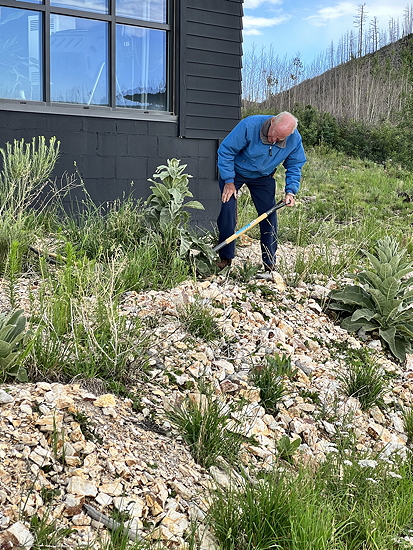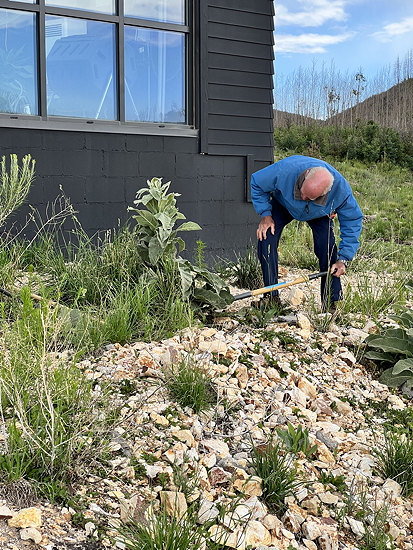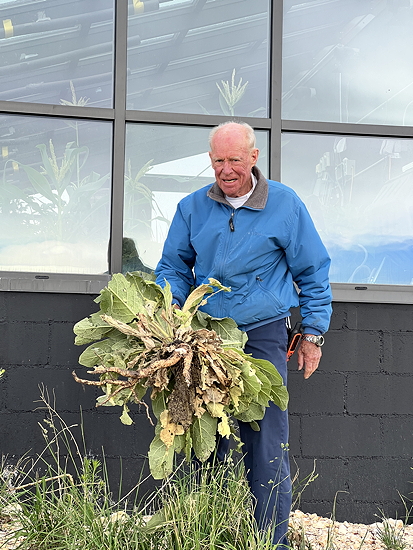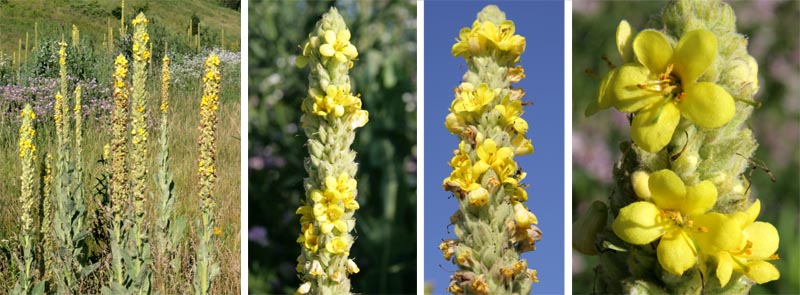I’m not sure Andy’s digging down to remove the roots of the entrenched mulleins is the best strategy.
It’s a lot of work and hard on the back.. If they don’t come up easily it might make more sense to cut the tops off and leave the roots in the ground.
The best strategy is to control common mullein while the population density is low. Plant numbers can easily expand from a few to hundreds per acre in just a couple years due to prolific seed production.
….
Sparse populations can be controlled by mechanical removal using a spade or shovel in late April and early May. Individual plants can be dug out or cut just at the soil surfaces as long as the whole rosette is removed. Single mowing of new 1-2 foot tall plants can reduce population and seed production for the season, especially in dry years.
—Controlling Common Mullein in Pastures
The main thing is to keep them from flowering so we don’t have gazillions of the tall ones growing fuel in our defensible space.
Individual plants produce 200-300 seed capsules, each containing 500-800 seeds, so that 100,000-240,000 seeds are produced per plant.
—Common Mullein, Verbascum thapsus
Anyway, Andy is doing it so it’s his call. He is experimenting with different techniques.
(There are a few more pictures here in Flickr.)
July 15, 2022








digging up the roots is such hard work. But leaving them mens that the mullein will come back, and the roots will continue to grow. Seems there is no good answer. Unless one is rich and can hire workers to dig them up!
It’s not clear. Left alone mulleins live for two years. The first year they put down a long tap root, the second year they produce flowers, then die. We don’t know what happens if the complete top is cut off at the soil line the second year before it flowers. Andy’s going to experiment.
interesting
(side tracked to a point where I’m just turning on laptop at nearly 10pm…long day at A/Field. But I did start “making” )
I’m looking forward to hearing about Abbeyfield. 🙂
That is a true battle to keep them from taking over. I hope Andy can come up with an easy solution
The main thing is to make sure they don’t flower in the defensible space.
Good grief, that’s an awful lot of seeds. Glad to say we don’t have mulleins in our garden and I’ve never seen any in the neighbourhood. Looks like Andy has a bit of an uphill task to get rid of them.
They mostly thrive when the soil has been disturbed and they have full sun. They are more drought tolerant than grass and other plants so I imagine they might be crowded out in areas that get a lot of moisture.
I can’t imagine the strength and resolve it takes to tackle that!
or Those! I mean if it were just one. but it seems like there’s no end to them!
kudos always to Andy. the patience he has for living on that piece of land.
he’s a wonder. it’s like Nature herself makes you fight for every little space!
Never a dull moment! It’s been an adventure. 🙂
they are absolutely beautiful plants and the flowers are gorgeous. If not for the fires you have, I would let them grow. I assume the grass I see in these photos has to be cleared away from the building. or will it all die back by itself except of course the biggest weed I have ever seen… I think your land is the best thing for Andy, like caring for our pool and yard is for bob. If he did not have to battle the land like he does, he would age quicker and soon not be able to do it. we watched the man accross the street, only 2 years older than Bob, stop doing anything outside, sit down in his chair and hire it all done, and he died 11 years ago, just from sitting in his recliner. Weed On Andy and enjoy. How boring life would be without your beautiful mountain top
The land is important for Andy’s mental and physical health. Fingers crossed he can keep doing it for a few more years. 🙂
These photographs make MY back hurt!
Please don’t over-do, either of you.
He says those big plants got away from him. They’re usually easy to pull out when the stalk is strong enough to pull on and the roots aren’t so big.